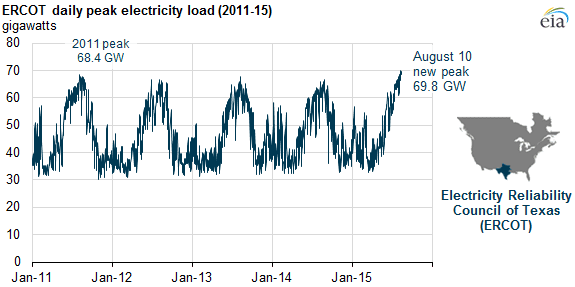Texas electric grid serves record-high power demand
During the recent heat wave in Texas, the Electricity Reliability Council of Texas (ERCOT), the operator of the electric grid covering most of the state, set a new record for electricity use when demand for electricity reached 69.8 gigawatts (GW) between 4:00 p.m. and 5:00 p.m. on August 10. ERCOT has been able to handle this extremely high demand without any system emergencies.
In its summer 2015 reliability assessment, the North American Electricity Reliability Corporation (NERC) had forecasted a higher reserve margin for Texas’s electric grid this summer (16.24%) compared with previous years (14.98% in 2014). Reserve margins reflect the amount of available generating capacity in the absence of unplanned outages at projected peak system demand. Reliability planning helps to ensure that there are enough electricity supply and transmission resources to meet demand even if there are unexpected outages of generation plants or transmission lines. Although sustained high summer temperatures and strong population and economic growth pushed peak demand higher than forecast, the grid has performed as expected.
In August 2011, ERCOT declared several emergencies in an effort to reduce electric demand. Rolling power outages were avoided because load curtailment was carried out through demand response and interruptible load contractual agreements, calls for voluntary conservation, and execution of short-term contracts that brought four generators back from nonoperating status. Since then, grid operators have worked to better ensure reliability in ERCOT.
Unlike all other U.S. regional transmission organization wholesale electricity markets, ERCOT has neither a capacity market nor a requirement that energy suppliers build or purchase reserve capacity to meet unexpected supply shortages. Instead, ERCOT allows wholesale prices to rise relatively higher than in other markets during system emergencies. This encourages consumers to conserve energy while relying on high wholesale electricity prices to spur investment in generation resources.




